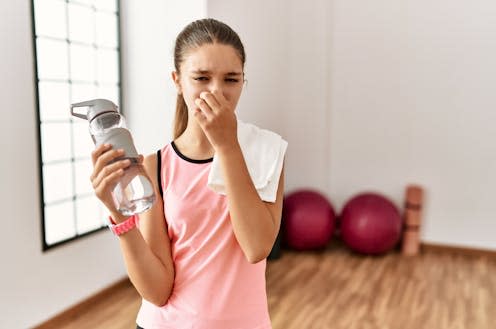Gym hygiene guide: the dangerous bacteria that lurk in dirty fitness equipment and clothes

A friend of mine, on a recent trip to the gym, declined to use the machine for drying his trunks – that gym equivalent of a salad spinner which removes excess water from your swimming costume. His reason? The amount of “faecal excrement” it was likely to contain.
I went ahead and used it – my own trunks were soaking. It was only later, when I reflected on his comments, that I wondered if he might be right.
A 2020 study, for example, examined the microbiome of skinfolds including the intergluteal cleft – the space between your buttocks. It identified an abundance of different microbes in this area, many of which were likely to have come from faecal contamination.
So perhaps my friend is correct, and the hygiene in communal spaces in gyms is on a par with a bowl of mixed nuts at the pub? You know, the one in which patrons may have dunked unwashed hands on their return from the toilet.
On further investigation, in addition to the hot tub, pool and showers (all of which can have well-known health risks), studies show there may well be other parts of your gym that aren’t as hygienic as you would hope.
Gym equipment
Gym equipment has multiple surfaces, nooks and crannies that come into contact with many unclean hands and sweaty bodies. One study analysed all these areas to identify the types of bacteria that could be festering there.
Among these in abundance were the bacteria firmicutes and actinobacteria, many examples of which are normally found in humans. Various firmicuta species make up the microbiome of the gut. I’ll leave it to your imagination to work out how they might have wound up on the handles of the pec deck.
These bacteria are known as commensals. In the gastrointestinal tract, they play an important role in good health, aiding digestion and absorption of nutrients.
More concerning was the presence of other bacteria that are known to cause serious illness, and which were found on treadmills, dumbbells, weight machines, exercise bikes and floor mats. These bacteria included salmonella and klebsiella, which are associated with food poisoning and pneumonia.
Any good gym should provide materials for users to wipe down and sanitise equipment before and after use. This is always a good idea, just in case the previous user hasn’t lived up to your exacting hygiene standards.
Gym wear
What about your gym kit? Skin is already a hodgepodge of different bacterial colonies. The main group is staphylococcus: these bacteria grow well in acidic conditions on the skin’s surface, but it’s a very changeable environment.
Exercise not only creates more moisture and a higher temperature but also friction between the skin and clothing – creating a breeding ground for potentially harmful bacteria like staphylococcus aureus and streptococcus pyogenes. These can cause harmful tissue infections, particularly if they manage to invade deeper regions of the skin.
Microbes can also transfer from skin on to clothing. Pop your gym kit into the moist, warm environment of your bag, and the problem may worsen. Bring your gym kit out again for another session – or two, or three – and the multiplication continues. Bacteria and fungal spores (even lice!) can latch on to clothing – although the synthetic fabrics in most gym wear make this more difficult.
The “not-of-this-Earth” smell that commonly arises from a used gym kit is usually a result of bacterial overgrowth, and the foul-smelling odorants they produce. Bacterial growth on skin varies between different regions of the body. The axillary (armpit) biome, for example, features corynebacterium – associated with a particularly malodorous scent.
Water bottles and earphones
I regularly do a deep clean of my water bottle, which can look revolting pretty quickly. I’ve even got to the stage of using cotton buds to get into the crevices around the screw top, which a sponge or dishwasher is unlikely to reach.
Like other gym paraphernalia, water bottles may harbour microbes that, when ingested, can cause symptoms including vomiting and diarrhoea. While there is no comprehensive study that has looked at the spectrum of bacteria that can be isolated from reusable bottles, individual studies have found klebsiella, pseudomonas and coliforms.
It may be possible that the bacteria spread to form a layer across the surfaces of the bottle – what we refer to as the biofilm. This might prove difficult to shift, requiring a more thorough cleaning job than just a quick rinse
There are, of course, other hidden nooks to consider. I wouldn’t be without music during my workout sessions, and have found my airpods can get grotty too. One study of swabbed earphones found the same bacteria that can generate ear infections.
It’s advisable, then, to wipe down all equipment before use, shower after every workout, and launder your gym kit in between sessions. At the very least, it’s good manners for your fellow gym-goers.
This article is republished from The Conversation under a Creative Commons license. Read the original article.

Dan Baumgardt does not work for, consult, own shares in or receive funding from any company or organisation that would benefit from this article, and has disclosed no relevant affiliations beyond their academic appointment.

 Yahoo News
Yahoo News 